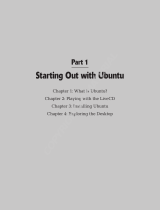
22
Part I ✦ SUSE Linux Basics
Data Partitions
Data partitions is a generic term for partitions that are formatted as a filesystem and
in which both the system and its users can store data. The partition designated as
the root filesystem is a special case of a data partition because it is required in
order to boot a Linux system.
The preceding sections explained how to create the swap and root partitions that
must be present to successfully boot a Linux system. However, you can also create
other data partitions, format them as filesystems, and specify their mount points
during the installation process. On Linux systems, a mount point is simply a Linux
directory through which a filesystem is made available to the system, known as
mounting that filesystem. Using regular directories as mount points is a clever part
of the design of Unix and Linux. If you run out of disk space on a given partition,
you can add another disk to your system, create data partitions there, copy the
data from existing directories to those partitions, and then mount the new parti-
tions on the directory where the data was originally located, effectively increasing
the amount of storage available to an existing system.
Today’s larger disks make it attractive to create other data partitions. You have sev-
eral reasons to consider creating multiple data partitions on today’s disks:
✦ When you boot a Linux system, the system checks the consistency of each of
its filesystems (as defined in the file
/etc/fstab — more about this in Chap-
ter 3). Checking the consistency of a single, huge, nonjournaled filesystem can
take quite a bit of time.
✦ Filesystem corruption can occur as a result of a number of problems, such
as a system crash, sudden power loss, or hardware problems. Whenever a
filesystem is corrupted, repairing it (which is mandatory) can cause you to
lose data. Creating multiple partitions reduces the extent to which filesystem
corruption can affect a single data partition.
✦ Keeping data on multiple partitions limits the chance that you can lose data
during a subsequent system upgrade. Some upgrades reformat the root parti-
tion or recreate its directory structure. If your user data is stored on other
data partitions, they will not be affected by changes to the root filesystem.
✦ Some Linux backup software backs up data on a per-partition basis. Backing
up a single huge partition can take quite a bit of time. Also, if your backups fail
(such as when a tape is corrupted), you may not be able to use the backups to
restore your system. Creating multiple partitions limits problems related to a
backup failure to a single partition.
Chapter 3 provides more detail about creating multiple partitions and the types of
filesystems supported by Linux and provides additional reasons why you may want
to create multiple partitions on your Linux system. Most types of Linux filesystems
can be resized once they have been created, enabling you to customize your sys-
tem’s partitioning, even after the system has been installed and is running.
06_754889 ch01.qxp 12/27/05 7:05 PM Page 22




















